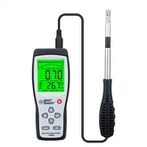Measurement principle of AC/DC clamp Ammeter
In general, Hall sensors are used to test DC current. Because AC clamp meters cannot use electromagnetic induction method. The Hall sensor is placed as shown in the following figure. The generated magnetic flux is proportional to the main DC and AC currents in the clamp head. This is detected by the Hall sensor and used as the output voltage to dissipate the magnetic flux
Hall sensor: It is a semiconductor that can generate a proportional voltage to the bias current generated by the measured object and generate an output terminal magnetic field when the bias current is applied to the input terminal.
How to operate the clamp Ammeter?
Generally, the operation of AC clamp Ammeter follows the CT principle, which is commonly used to obtain the magnetic flux when the current passes through the conductor. Assuming that the current passing through the conductor is the main current, we can obtain a current proportional to the main current through the electromagnetic induction generated by the secondary coil of the clamp (which is connected to the circuit of the tested object). This allows us to read the AC current (when using digital clamp Ammeter)
Please refer to the flowchart below for details:
Comparison function:
Select and set standard insulation values in various measurement ranges and compare them with readings.
Obtain results by comparing the fail or pass signals displayed on the screen and paying attention to the beep sound
The beep reminder can be associated with a fail or pass based on user requirements






